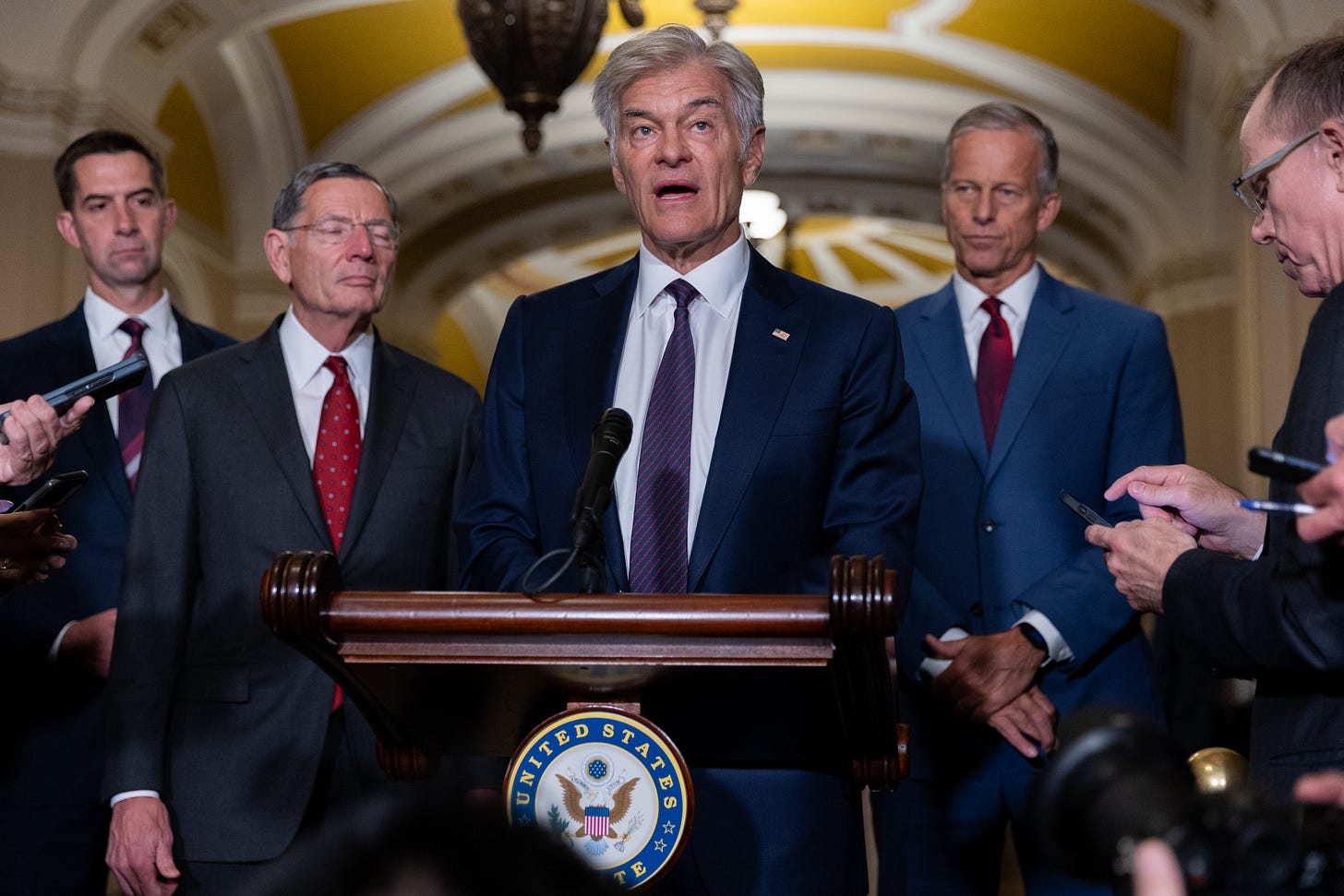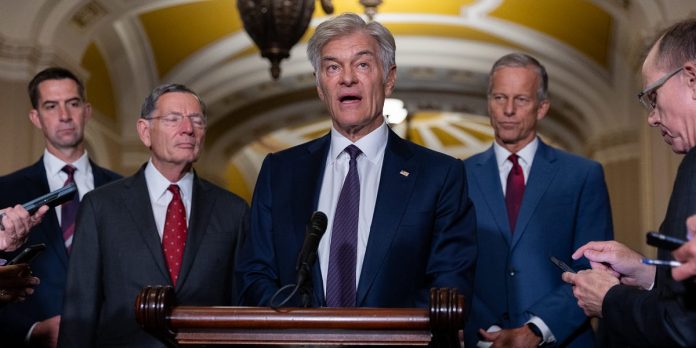
REPUBLICANS APPEAR TO HAVE finally figured out that the coming insurance premium spike for more than 20 million Americans will hurt many of their own constituents—and, not coincidentally, damage their party’s prospects for next year’s midterm elections.
They just haven’t figured out what to do about it.
Florida Senator Rick Scott keeps talking like the looming expiration of those enhanced Affordable Care Act subsidies is an opportunity to get rid of the law’s private insurance reforms once and for all, and simply give people money they can use to pick their own coverage or pay their own medical bills directly. Louisiana Senator Bill Cassidy is promoting a far more limited plan, one that would simply take the money now being used to fund those enhanced subsidies and use it instead to fill individual private accounts, which people could use to cover copays, deductibles and other out-of-pocket costs.
House Speaker Mike Johnson hasn’t committed to anything so specific, promising instead that his caucus has “lots of ideas” to be “rolled out in the next couple of weeks.” Mehmet Oz, administrator for Medicare and Medicaid, says actually everything is on the table. “There are many ideas out there,” he told CNN’s Dana Bash on Sunday. “Some of them could replace Obamacare. Many of them will not.”
And then there is Donald Trump, who on Tuesday morning posted (sorry for the all-caps) that “THE ONLY HEALTHCARE I WILL SUPPORT OR APPROVE IS SENDING THE MONEY DIRECTLY BACK TO THE PEOPLE, WITH NOTHING GOING TO THE BIG, FAT, RICH INSURANCE COMPANIES. . . . THE PEOPLE WILL BE ALLOWED TO NEGOTIATE AND BUY THEIR OWN, MUCH BETTER, INSURANCE. POWER TO THE PEOPLE! “
The post seems to reflect about as much deep thinking as Trump usually puts into policy—which is to say, not much. It also raises a bunch of questions.
Where is this new, much better insurance going to come from, if not from the “big, fat insurers”? Exactly how are people going to negotiate with insurers, and over what? Prices? Benefits? Is this a scheme for wrecking—i.e., repealing—the Affordable Care Act’s rules and regulations that protect people with pre-existing conditions, like Scott wants? Or is this a substitute only for the enhanced subsidies, as Cassidy is proposing?
Trying to extract and analyze a concrete, coherent policy proposal out of these kinds of statements is pretty much impossible—or, as Harvard health policy professor Adrianna McIntyre put it to me, like “trying to read tea leaves, only the cup is full of mud.” But Trump and the other Republican leaders do seem to have coalesced around at least one idea: that taking some or all of the money now going to insurers, and giving it directly to people, will make for a cheaper, more efficient health care system.
The concept is not new. It’s been kicking around in health policy for decades, as a way for both the public and the private sector to get health care costs under control. It’s also been implemented in a variety of places, in a variety of forms. Which means there’s a lot of evidence of how it works in practice. And that evidence is pretty discouraging.
A FUNDAMENTAL CHALLENGE of any insurance scheme is how to avoid what economists call “moral hazard,” which, in this context, refers to the potential of insurance to discourage responsible or cost-conscious behavior because insurance has insulated those who buy it from financial danger. Overly protective property insurance, for example, might discourage an owner from investing in updated smoke detectors since they know that fire damage will be covered by the insurer. Overly generous auto insurance might lead a driver to be less careful on the roads.
One way of combatting moral hazard is to make sure whoever has insurance remains responsible for some of the costs of misfortune. In health insurance, that can take the form of copayments, coinsurance, and deductibles. In the 1970s and 1980s, when rising health costs first became a major topic of national political conversation, both political and corporate leaders began looking for ways to increase these out-of-pocket costs, in the hopes that giving people more “skin in the game” would get medical spending under control.
Among the big champions of this approach was Republican Newt Gingrich, who as House speaker in the 1990s embraced the idea of pairing high-deductible private insurance with tax-favored, private saving accounts people could use to pay the out-of-pocket costs. He even eyed it as an option for people in Medicare, as an alternative to the traditional program.
That particular version did not prove especially popular, in part because seniors—who expect to have high medical costs—perceived it as a way to give them less help with their medical bills. Among other things, they knew Gingrich was looking to cut Medicare spending overall, and figured whatever money got deposited in those accounts wouldn’t be enough to cover their bills. That was enough to kill the idea, at least as far as Medicare goes.
But private employers were able to plow ahead, leaning increasingly on higher out-of-pocket costs as a way to hold down the expense of insurance they provided to employees. This has become the standard for private insurance in America today. And while employees have not exactly been thrilled about this development, advocates for this approach have talked it up as a way to empower individuals—and to unleash what they call “consumer-driven health care.”
The theory is that with a combination of incentives and information, people can go around and shop for the best deals on health care—by, for example, seeking out cheaper sources of prescription drugs or MRI centers that will offer the lowest prices per scan. This, in turn, is supposed to force anybody providing medical care to compete on price and quality, unleashing market forces that would drive the entire system towards greater efficiency.
Pretty much every Republican talking about health care in the last few weeks has offered a version of this. “We empower patients to shop, to find the best deal for their dollar,” Cassidy said in a recent floor speech. “That drives competition and that lowers cost.”
IT SOUNDS LOVELY. But scholars have now had many years to see how this approach works out in practice. “There’s loads of evidence on this, zillions of studies,” Sherry Glied, a professor and health economist at New York University, told me. “Essentially they show that no one shops.”
One reason, Glied explained, is the reality of what it’s like to get medical care. “Once you’re in the system and you’ve decided to go to the doctor, you pretty much do whatever the doctor says, and certainly once you’re in the hospital, you do whatever is recommended,” said Glied, who is the author of widely cited research on the subject. “When you’re in the emergency room, nobody says to you, ‘Would you like to have this CT scan or not?’”
Glied added that the best evidence in favor of the “consumer-directed” approach comes from a pilot program in the health system for California retirees, in which the administrators made sure beneficiaries knew where to get cheaper, but still high-quality knee replacements. A widely cited study found people did indeed gravitate toward those cheaper providers.
But, she noted, knee replacements represent the best-case scenario for shopping—a discrete procedure that can be planned well in advance, and for which people can carefully compare prices. That’s simply not possible in many health care contexts, especially when charges for most medical services typically consist of multiple fees, with all kinds of confusing codes and jargon.
Employers and insurers have even invested in online apps, in the hopes of helping consumers navigate this mess and find the best deals. But the tools just don’t work that well—not even for a relatively routine doctor’s visit, let alone for a hospital stay.
“You both need to have magical insight into what your doctor is going to do during your visit, and what they’re going to bill you for,” McIntyre said. “And then also, you have to trust that the information your price shopping tool has is the most up-to-date information and is accurate for the specific provider you are seeing. We’ve seen with other such tools—like provider listings in networks—that frequently doesn’t happen.”
But the bigger worry for many experts is the possibility that shifting more costs onto individuals will lead them to cut back on care they need. When they don’t get the care they need now, they may end up spending even more for care they need later; even if they spend less, they’re likely to end up in worse shape medically.
“When people do have a high deductible, they cut back on the good stuff as much as they cut back on the low value stuff,” Tom Buchmueller, a health economist at the University of Michigan, told me. “Even when people are incentivized to be consumers, they are not very good consumers.”
The effects can be particularly tough on lower-income people, who are at once more likely to have serious, chronic conditions that need attention, more likely to be price sensitive about consuming health care, and more likely to have difficulty researching options for care and providers. So they’re the ones most likely to skip a doctor’s visit or recommended test—or split or skip prescriptions—to save money.
THE ARCHITECTS OF THE AFFORDABLE CARE ACT actually tried to find a policy sweet spot—a way to put enough expenses onto individuals to promote some cost-consciousness but without making the out-of-pocket costs so high it discouraged people from getting care they needed or exposed them to overly punishing expenses.
That is why all but the most generous plans available to people through the Affordable Care Act marketplaces have substantial deductibles, well into the thousands of dollars, but preventive care is free and people at lower incomes can get policies with much lower out-of-pocket costs.
Even with those provisions, the high deductibles were a source of frustration and criticism when the Affordable Care Act first took full effect in 2014. It’s one reason Democrats were so eager to add extra financial assistance—which they did during the pandemic—and then renew it. With the enhanced subsidies, millions were able to “buy up” and get policies with lower deductibles and copays.
But those enhanced subsidies were extended only through the end of this year. And now a replacement is being left to whatever the Trump White House and Republican leaders are willing to cook up or sign off on.
It’s impossible to get specific about the likely effects of their replacement proposals without having actual, fleshed-out legislation, because so much depends on the details—like whether the accounts meant to replace the enhanced subsidies would be health saving accounts (which accrue over time) or flexible savings accounts (which must be spent within the year), how the amounts would be calculated and when they would be paid out, what kind of restrictions would come on the uses of the accounts, and so on.
Figuring that out would take time. So would debating and passing a law to put one of these schemes in place, as would setting up whatever legal and practical mechanisms the new scheme might require. Meanwhile, open enrollment is currently in its third week and the new plan year starts in less than two months. People are already shopping and making decisions, and within a few weeks they’ll be paying premiums unless they decide the price spike makes coverage unaffordable—as nearly 4 million people are expected to do.
“If this is an idea that you really want to develop, then fine, do it for next year’s open enrollment, do it down the line,” Buchmueller, who served in HHS under the Biden administration, told me. “There are so many operational details that you’d have to work out—how are you not going to get it completely wrong?”
AN ALTERNATIVE APPROACH does exist. Earlier this month, two House Republicans and two House Democrats put forward a bill that would extend the existing subsidies for two years, with a few modest changes (like phasing out eligibility at higher incomes) to accommodate some of the concerns Republicans have made about the cost of the enhanced subsidies.
It’s not hard to imagine something like that passing if the White House and GOP leaders would allow the bill to get a vote. That would leave Republicans plenty of time to work out—and then implement—whatever bigger changes they have in mind, while sparing more than 20 million Americans a jump in health care costs next year. Republicans could even take the opportunity to consider new ideas, or to work on bipartisan methods of holding down costs.
Of course, a longer debate would also mean confronting the downsides and tradeoffs of what Republicans seem to have in mind right now. It would mean addressing—and answering—all the evidence showing that “shopping” for health care doesn’t lead to more efficient care. And it would force Republicans to prove that whatever they propose wouldn’t simply amount to less financial assistance on health care, which would almost surely mean more hardship for people with lower incomes and serious medical needs.
That might be pretty tough for them to do. “Cash accounts to pay for health services will never provide the kind of access to health care that people who become ill, get into an accident, or have pre-existing conditions need or the kind of financial protection that health insurance provides,” Gideon Lukens, senior fellow at the left-leaning Center on Budget and Policy Priorities, wrote in an analysis of the concepts Republicans have been floating.
That conclusion was based in part on the history of GOP policy—a history littered with promises of better, cheaper health care that somehow never match up with their actual proposals, if those proposals are ever introduced at all. There’s no reason to think this month’s confused, frenzied rush to devise policy in time for 2026 will turn out any different.







